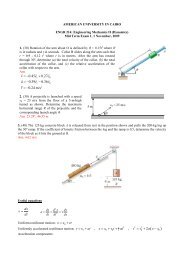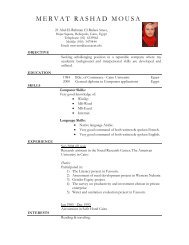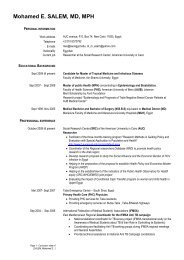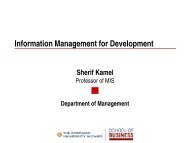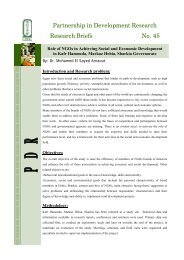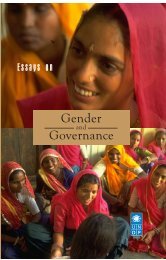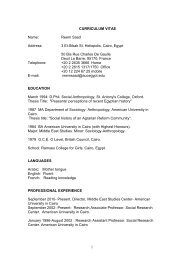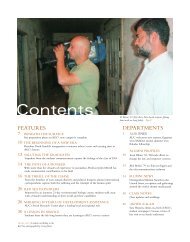Family poultry production to combat poverty Case study of villages in ...
Family poultry production to combat poverty Case study of villages in ...
Family poultry production to combat poverty Case study of villages in ...
Create successful ePaper yourself
Turn your PDF publications into a flip-book with our unique Google optimized e-Paper software.
Partnership <strong>in</strong> Development Research<br />
Research Briefs No. 43<br />
<strong>Family</strong> <strong>poultry</strong> <strong>production</strong> <strong>to</strong> <strong>combat</strong> <strong>poverty</strong><br />
<strong>Case</strong> <strong>study</strong> <strong>of</strong> <strong>villages</strong> <strong>in</strong> Menoufia governorate<br />
By: Dr. Yousri Abdel Mawla<br />
Introduction and research problem:<br />
Poverty ranks among the ma<strong>in</strong> problems fac<strong>in</strong>g Egyptian rural areas. The Human<br />
Development Report <strong>in</strong>dicated that 58% <strong>of</strong> the poor <strong>in</strong> Egypt live <strong>in</strong> the rural areas<br />
where <strong>poverty</strong> is a multi-dimensional problem given the limited share <strong>of</strong><br />
<strong>in</strong>dividuals <strong>in</strong> agricultural land, limited <strong>in</strong>vestments <strong>in</strong> the agricultural sec<strong>to</strong>r <strong>in</strong><br />
addition <strong>to</strong> the poor wages <strong>in</strong> agriculture. The <strong>in</strong>tensity <strong>of</strong> <strong>poverty</strong> also <strong>in</strong>creases<br />
with the cont<strong>in</strong>uous changes <strong>in</strong> the styles <strong>of</strong> life and work habits <strong>in</strong> the Egyptian<br />
rural areas.<br />
Concern with <strong>poverty</strong> emanates from concern with human development. Build<strong>in</strong>g<br />
human capacities and provid<strong>in</strong>g <strong>in</strong>dividuals with the opportunities <strong>to</strong> use their<br />
potentials through material <strong>in</strong>vestments, is one <strong>of</strong> the ways <strong>to</strong> reduce <strong>poverty</strong> and<br />
enable people <strong>to</strong> control their lives. Among the ma<strong>in</strong> material and human assets <strong>in</strong><br />
the rural areas are the <strong>poultry</strong>-related activities because <strong>poultry</strong> is easy <strong>to</strong> look after<br />
and require little capital. Thus, the aim <strong>of</strong> this <strong>study</strong> is raise awareness about<br />
<strong>poultry</strong> projects and ways <strong>to</strong> develop them through technical assistance and<br />
market<strong>in</strong>g as a solution <strong>to</strong> the problem <strong>of</strong> limited <strong>in</strong>come.<br />
Objectives:<br />
Home-<strong>poultry</strong> projects contribute <strong>to</strong> <strong>in</strong>creas<strong>in</strong>g the <strong>in</strong>come <strong>of</strong> rural families. Rural<br />
women <strong>in</strong> particular play a major role <strong>in</strong> rais<strong>in</strong>g and market<strong>in</strong>g <strong>poultry</strong>. Thus, this<br />
<strong>study</strong> discusses the <strong>poultry</strong> <strong>production</strong> system <strong>in</strong> some <strong>villages</strong> <strong>in</strong> Menoufia<br />
governorate. The objectives can be summarized as follows:<br />
-Determ<strong>in</strong>e the skills and knowledge <strong>of</strong> housewives concern<strong>in</strong>g different aspects <strong>of</strong><br />
<strong>poultry</strong> <strong>production</strong>.<br />
-Identify the ma<strong>in</strong> sources <strong>of</strong> housewives’ knowledge about <strong>poultry</strong><br />
-Determ<strong>in</strong>e rural house wives’ knowledge <strong>of</strong> the services <strong>of</strong>fered by the<br />
Agricultural Extension department <strong>in</strong> the area <strong>of</strong> <strong>poultry</strong> <strong>production</strong> and the types<br />
<strong>of</strong> services <strong>of</strong>fered.
Research Briefs No. 43<br />
-Identify the technical aspects <strong>of</strong> <strong>poultry</strong> <strong>production</strong> through identify<strong>in</strong>g the op<strong>in</strong>ions <strong>of</strong> different<br />
categories <strong>of</strong> stakeholders participat<strong>in</strong>g <strong>in</strong> this <strong>in</strong>dustry.<br />
-Determ<strong>in</strong>e the obstacles <strong>of</strong> dissem<strong>in</strong>at<strong>in</strong>g and develop<strong>in</strong>g <strong>poultry</strong> <strong>production</strong> from the perspective <strong>of</strong><br />
the different ac<strong>to</strong>rs <strong>in</strong>volved.<br />
-Identify the suggestions <strong>of</strong> different ac<strong>to</strong>rs <strong>in</strong>volved <strong>in</strong> the <strong>poultry</strong> <strong>in</strong>dustry <strong>in</strong> order <strong>to</strong> improve this<br />
<strong>in</strong>dustry.<br />
Determ<strong>in</strong>ants:<br />
The <strong>study</strong> focuses primarily on the ma<strong>in</strong> elements <strong>of</strong> <strong>poultry</strong> <strong>production</strong>: rural housewives, egg<br />
distribu<strong>to</strong>rs, owners <strong>of</strong> shops for veter<strong>in</strong>ary medications, distribu<strong>to</strong>rs <strong>of</strong> <strong>poultry</strong>, owners <strong>of</strong> <strong>poultry</strong><br />
farms, distribu<strong>to</strong>rs <strong>of</strong> animal fodder, and agricultural advisers <strong>in</strong> the area <strong>of</strong> <strong>poultry</strong>. Later on, the last<br />
category was excluded because <strong>of</strong> the absence <strong>of</strong> specialists <strong>in</strong> this area on the level <strong>of</strong> the village.<br />
There are only specialized agricultural advisors <strong>in</strong> this area on the adm<strong>in</strong>istrative level <strong>of</strong> the markaz,<br />
but their ma<strong>in</strong> task is <strong>to</strong> provide different breeds <strong>to</strong> <strong>villages</strong>.<br />
Summary <strong>of</strong> f<strong>in</strong>d<strong>in</strong>gs:<br />
Socio-economic characteristics <strong>of</strong> the ma<strong>in</strong> ac<strong>to</strong>rs:<br />
1. Rural women (180 respondents)<br />
F<strong>in</strong>d<strong>in</strong>gs <strong>in</strong>dicated that the majority <strong>of</strong> female respondents are married and work<strong>in</strong>g. The age <strong>of</strong> 61%<br />
<strong>of</strong> the women ranges between 18-32 years. Half <strong>of</strong> the respondents are affiliated <strong>to</strong> 5-7 member<br />
families and the other half are distributed between small and large- size families. 26% <strong>of</strong> the women<br />
are illiterate and 51% have secondary degree and above (3% only have university degrees). Three<br />
quarters <strong>of</strong> the women have 6 <strong>to</strong> 9 house appliances and the majority reported that the <strong>in</strong>come <strong>of</strong> their<br />
families is not sufficient o meet their needs (40%) or is barely sufficient (31%). Two thirds <strong>of</strong> the<br />
respondents tend <strong>to</strong> pay frequent visits <strong>to</strong> neighbor<strong>in</strong>g <strong>villages</strong>, and moderate number <strong>of</strong> visits <strong>to</strong> other<br />
governorates and marakez. Half the respondents have a 1 <strong>to</strong> 9 years <strong>of</strong> expertise.<br />
2. Egg distribu<strong>to</strong>rs (12 distribu<strong>to</strong>rs)<br />
Half the egg distribu<strong>to</strong>rs are <strong>in</strong> the age group 33 <strong>to</strong> 43 and hold <strong>in</strong>termediate educational degrees.<br />
Two thirds <strong>of</strong> the egg distribu<strong>to</strong>rs have limited experience <strong>in</strong> the area <strong>of</strong> <strong>poultry</strong> (2-6 years) and half <strong>of</strong><br />
them have never attended sem<strong>in</strong>ars or meet<strong>in</strong>gs on <strong>poultry</strong> <strong>production</strong>. Two thirds have never<br />
attended tra<strong>in</strong><strong>in</strong>g sessions on how <strong>to</strong> raise <strong>poultry</strong>. 58% <strong>of</strong> the egg distribu<strong>to</strong>rs have modest land<br />
hold<strong>in</strong>gs (20-45 kirats) and 42% have additional jobs (mostly civil servants).
Research Briefs No. 43<br />
3. Owners <strong>of</strong> shops for sell<strong>in</strong>g veter<strong>in</strong>ary medications (10 respondents)<br />
Data <strong>in</strong>dicated that half the shop owners who sell veter<strong>in</strong>ary medications are <strong>in</strong> the age group 39-42;<br />
40% have university degrees and 30% have <strong>in</strong>termediate degrees. Two thirds <strong>of</strong> the shop owners have<br />
medium experience (10-12 years) <strong>in</strong> the area <strong>of</strong> <strong>poultry</strong> <strong>production</strong>. 70% <strong>of</strong> the shop owners reported<br />
that they attended meet<strong>in</strong>gs <strong>to</strong> discuss <strong>poultry</strong> and half <strong>of</strong> them had attended tra<strong>in</strong><strong>in</strong>g rounds <strong>in</strong> this<br />
area. 60% hold 46 kirats or more and the majority have additional work (civil servants or veter<strong>in</strong>ary<br />
<strong>in</strong>spec<strong>to</strong>rs)<br />
4. Poultry distribu<strong>to</strong>rs (11 distribu<strong>to</strong>rs)<br />
Half the <strong>poultry</strong> distribu<strong>to</strong>rs are <strong>in</strong> the age group 36-41. Two thirds <strong>of</strong> the respondents have an<br />
<strong>in</strong>termediate degree and the experience <strong>of</strong> three fourths <strong>of</strong> the respondents is limited <strong>to</strong> the area <strong>of</strong><br />
<strong>poultry</strong> (3-11 years). Three thirds <strong>of</strong> the distribu<strong>to</strong>rs have never attended meet<strong>in</strong>gs or tra<strong>in</strong><strong>in</strong>g sessions<br />
<strong>in</strong> this area and the majority have limited landhold<strong>in</strong>gs (15-64 kirats). Half <strong>of</strong> the respondents have<br />
additional jobs (workers or civil servants).<br />
5.Animal fodder distribu<strong>to</strong>rs (12 distribu<strong>to</strong>rs)<br />
58% <strong>of</strong> the animal fodder respondents are <strong>in</strong> the age group 35-44 years. Half the respondents have<br />
<strong>in</strong>termediate education and the expertise <strong>of</strong> 58% ranges between 2 and 6 years. The majority did not<br />
attend any sem<strong>in</strong>ars or tra<strong>in</strong><strong>in</strong>g session <strong>in</strong> the area, and around 58% have limited landhold<strong>in</strong>gs (15-33<br />
kirats). Three quarters have additional jobs (civil servants and workers).<br />
Housewives’ Skills and Knowledge <strong>in</strong> the area <strong>of</strong> Poultry <strong>production</strong>:<br />
1. Characteristics <strong>of</strong> the hatch<strong>in</strong>g eggs:<br />
Data <strong>in</strong>dicated that many respondents have knowledge about the characteristics <strong>of</strong> hatch<strong>in</strong>g eggs and<br />
rarely did the knowledge fall below 50%.<br />
2. Nurs<strong>in</strong>g operation:<br />
Female respondents have non- reliable sources <strong>to</strong> purchase chickens. They also rely on egg lay<strong>in</strong>g,<br />
and buy<strong>in</strong>g from specialized farms. Agricultural Extension comes last among the buy<strong>in</strong>g sources<br />
possibly because they do not <strong>of</strong>fer this service. Almost all respondents raise baladi chicken. One<br />
third only raise improved hybrids, <strong>in</strong> addition <strong>to</strong> baladi chicken.
Research Briefs No. 43<br />
Most respondents place the chicken <strong>in</strong> a card boxes with holes. 27% only use ord<strong>in</strong>ary boxes. Half<br />
the respondents expose the chickens <strong>to</strong> normal weather as they move them from the place <strong>of</strong> purchase<br />
<strong>to</strong> the house. Two thirds <strong>of</strong> the women place the chickens next <strong>to</strong> each other without leav<strong>in</strong>g space<br />
between them as they transport them home, possibly because many <strong>of</strong> them buy the chickens from<br />
near- by street vendors and not from distant sources that require proper transportation. In that case,<br />
the purchase process takes only a few m<strong>in</strong>utes until the chickens are f<strong>in</strong>ally placed <strong>in</strong> their f<strong>in</strong>al place.<br />
It is important <strong>to</strong> raise awareness about the need <strong>to</strong> take precautions if the chickens are <strong>to</strong> travel for<br />
long distances. F<strong>in</strong>d<strong>in</strong>gs <strong>in</strong>dicated that the majority <strong>of</strong> respondents know about the conditions required<br />
<strong>to</strong> raise <strong>poultry</strong> and that the space needed <strong>to</strong> raise them should be appropriate relative <strong>to</strong> the number <strong>of</strong><br />
chickens.<br />
3. Feed<strong>in</strong>g and care:<br />
The <strong>study</strong> po<strong>in</strong>ted <strong>to</strong> a high level <strong>of</strong> knowledge among respondents with regard <strong>to</strong> proper feed<strong>in</strong>g <strong>of</strong><br />
chickens dur<strong>in</strong>g the <strong>in</strong>cubation period. However, it is still important <strong>to</strong> raise awareness about the need<br />
<strong>to</strong> provide them with f<strong>in</strong>e and clean sand dur<strong>in</strong>g the first days particularly <strong>in</strong> the <strong>villages</strong> <strong>of</strong> Abu<br />
Mashhour, Al Makate’ and Toukh Tabansha. It was also <strong>in</strong>dicated that the majority <strong>of</strong> respondents<br />
were fully aware <strong>of</strong> the appropriate utensils for feed<strong>in</strong>g chicken and the need <strong>to</strong> keep them <strong>in</strong> closed<br />
areas. It is also important not <strong>to</strong> disturb the hens so that their eggs don’t decrease, particularly <strong>in</strong> the<br />
<strong>villages</strong> <strong>of</strong> Al Asatla and Sobk el Dahak, and provide light<strong>in</strong>g for 16 <strong>to</strong> 18 hours every day. Chickens<br />
have <strong>to</strong> be disposed <strong>of</strong> after a maximum <strong>of</strong> two years.<br />
With regard <strong>to</strong> medical care, respondents’ knowledge about the diseases that chickens could get and<br />
means <strong>of</strong> contract<strong>in</strong>g diseases and prevention was limited. Half the respondents only knew about<br />
symp<strong>to</strong>ms and prevention <strong>of</strong> white diarrhea and only 20% knew about Newcastle and other diseases.<br />
Respondents relied ma<strong>in</strong>ly on their <strong>in</strong>dividual knowledge as well as on their families and neighbors <strong>to</strong><br />
obta<strong>in</strong> <strong>in</strong>formation about <strong>poultry</strong> rais<strong>in</strong>g. Mass media <strong>in</strong>clud<strong>in</strong>g television and radio as well as<br />
agricultural guidance came at a later stage as sources <strong>of</strong> <strong>in</strong>formation on <strong>poultry</strong>, which confirms the<br />
need <strong>to</strong> enhance the role <strong>of</strong> mass media and agricultural counsel<strong>in</strong>g <strong>in</strong> rais<strong>in</strong>g the awareness <strong>of</strong> women<br />
and their families about agricultural <strong>production</strong> activities.<br />
Services <strong>of</strong>fered by Agricultural Extension <strong>to</strong> <strong>in</strong>crease the <strong>production</strong> <strong>of</strong> <strong>poultry</strong>:<br />
Study f<strong>in</strong>d<strong>in</strong>gs <strong>in</strong>dicated that two thirds <strong>of</strong> the respondents had no idea about counsel<strong>in</strong>g services<br />
<strong>of</strong>fered by Agricultural Guidance <strong>to</strong> <strong>in</strong>crease the <strong>production</strong> <strong>of</strong> <strong>poultry</strong>, with the exception <strong>of</strong> the<br />
Makate’ village, where women had a relatively good idea <strong>of</strong> the importance <strong>of</strong> agricultural extension<br />
and what it does <strong>to</strong> <strong>in</strong>crease <strong>poultry</strong> <strong>production</strong>.
Research Briefs No. 43<br />
Two thirds <strong>of</strong> the respondents who had an idea about the counsel<strong>in</strong>g services <strong>of</strong>fered by Agricultural<br />
Extension <strong>to</strong> <strong>in</strong>crease <strong>poultry</strong> <strong>production</strong> reported that they provide improved breeds as well as fodder.<br />
Half the respondents said that they undertake the vacc<strong>in</strong>ation <strong>of</strong> chicken aga<strong>in</strong>st disease, while 42%<br />
said they provided leaflets about <strong>poultry</strong> and a small percentage reported that they provides foreign<br />
breeds (14%).<br />
Technical aspects <strong>of</strong> <strong>poultry</strong> <strong>production</strong>:<br />
The <strong>study</strong> <strong>in</strong>dicated that the eggs <strong>of</strong> hens are the only type <strong>of</strong> eggs sold by egg traders and that they<br />
are sold <strong>in</strong> paper plates or <strong>in</strong> plastic bags. Housewives are the ma<strong>in</strong> purchasers <strong>of</strong> eggs <strong>in</strong>side the<br />
village, a fact that must be taken <strong>in</strong><strong>to</strong> account as we design awareness rais<strong>in</strong>g programs <strong>in</strong> the village.<br />
Excess eggs are sold by <strong>in</strong>stallments or are s<strong>to</strong>red <strong>in</strong> shops.<br />
Owners <strong>of</strong> veter<strong>in</strong>ary medic<strong>in</strong>es said that antibiotics for <strong>in</strong>test<strong>in</strong>al and bronchial disorders are among<br />
the ma<strong>in</strong> medications on sale, followed by vitam<strong>in</strong>s and vacc<strong>in</strong>ations aga<strong>in</strong>st contagious diseases.<br />
Housewives, family heads and owners <strong>of</strong> <strong>poultry</strong> farms are among the ma<strong>in</strong> consumers <strong>of</strong> medic<strong>in</strong>es.<br />
Owners <strong>of</strong> shops <strong>of</strong>fer <strong>in</strong>formation <strong>to</strong> the consumers for free.<br />
Chicken distribu<strong>to</strong>rs distribute live chicken and only one third sell them slaughtered. Housewives are<br />
the ma<strong>in</strong> consumers <strong>of</strong> sold chicken, followed by various members <strong>of</strong> the family, children and f<strong>in</strong>ally<br />
the family head. The <strong>study</strong> <strong>in</strong>dicated that the only way <strong>to</strong> dispose <strong>of</strong> slaughter<strong>in</strong>g waste is through<br />
garbage vehicles, dump<strong>in</strong>g <strong>in</strong> the canal, burn<strong>in</strong>g or sell<strong>in</strong>g. Owners <strong>of</strong> <strong>poultry</strong> farms reported that<br />
their chickens run around on the ground and are not kept <strong>in</strong> boxes.<br />
Dead <strong>poultry</strong> is burned, dumped <strong>in</strong> canals or disposed <strong>of</strong> <strong>in</strong> garbage vehicles. Eggs are collected <strong>in</strong><br />
new or used plates or <strong>in</strong> buckets or card boxes. Most owners <strong>of</strong> <strong>poultry</strong> farms place the eggs on their<br />
lower tip which would only allow a short s<strong>to</strong>r<strong>in</strong>g period, whereas plac<strong>in</strong>g them on the <strong>to</strong>p side would<br />
allow for longer s<strong>to</strong>r<strong>in</strong>g periods. The majority <strong>of</strong> respondents reported that they sell their egg<br />
<strong>production</strong> daily, or s<strong>to</strong>re it. They reported that the ma<strong>in</strong> consumers <strong>of</strong> their products are distribu<strong>to</strong>rs,<br />
ord<strong>in</strong>ary consumers then companies. Cracked eggs are sold, eaten or dumped <strong>in</strong> the garbage. Poultry<br />
waste is disposed <strong>of</strong> through sale, plac<strong>in</strong>g <strong>in</strong> the field, or dump<strong>in</strong>g <strong>in</strong> canals. Most owners use<br />
dis<strong>in</strong>fectants <strong>in</strong> their farms.<br />
Study f<strong>in</strong>d<strong>in</strong>gs <strong>in</strong>dicated that half the fodder distribu<strong>to</strong>rs obta<strong>in</strong> fodder from fac<strong>to</strong>ries. Less than half<br />
manufacture the fodder themselves and a limited number buy it from wholesale traders. Chicken and<br />
duck fodder is the most common type they manufacture, then fodder for fatten<strong>in</strong>g, egg chickens and<br />
fodder for rabbits. Two thirds <strong>of</strong> the fodder distribu<strong>to</strong>rs reported that they do not follow any particular<br />
fodder composition.
Research Briefs No. 43<br />
Challenges fac<strong>in</strong>g <strong>poultry</strong> <strong>production</strong>:<br />
Study f<strong>in</strong>d<strong>in</strong>gs <strong>in</strong>dicated that the most important challenges fac<strong>in</strong>g <strong>poultry</strong> <strong>production</strong> among female<br />
respondents is the death <strong>of</strong> the chickens (69%), high costs <strong>of</strong> breed<strong>in</strong>g (65%), children are busy with<br />
their studies and have no time <strong>to</strong> help (39%), lack <strong>of</strong> awareness about <strong>poultry</strong> diseases (38%), lack <strong>of</strong><br />
manpower (34%), shortage <strong>of</strong> fodder 31%), shortage <strong>of</strong> hatch<strong>in</strong>g eggs (26%), absence <strong>of</strong> organizations<br />
concerned with <strong>poultry</strong> <strong>production</strong> (24%), shortage <strong>of</strong> vacc<strong>in</strong>es and medications (23%), difficulty <strong>of</strong><br />
market<strong>in</strong>g (21%), primitive breed<strong>in</strong>g methods (20%), and shortage <strong>of</strong> chickens (19%).<br />
Most distribu<strong>to</strong>rs agreed that the ma<strong>in</strong> problem fac<strong>in</strong>g egg distribu<strong>to</strong>rs <strong>in</strong> the village is speculation <strong>in</strong><br />
the prices <strong>of</strong> eggs, eggs spoil rapidly <strong>in</strong> the summer, farmers do not like <strong>to</strong> buy eggs <strong>in</strong> plates and<br />
difficulty <strong>of</strong> market<strong>in</strong>g eggs <strong>in</strong> the <strong>villages</strong> because farmers raise their own <strong>poultry</strong> <strong>in</strong> their homes.<br />
Owners <strong>of</strong> veter<strong>in</strong>ary medications’ shops reported that from their po<strong>in</strong>t <strong>of</strong> view there is no awareness<br />
among breeders on how <strong>to</strong> properly dispose <strong>of</strong> dead chickens and <strong>poultry</strong> diseases, and the shortage <strong>of</strong><br />
new disease- resistant breeds.<br />
The problems fac<strong>in</strong>g chicken distribu<strong>to</strong>rs are the long distance <strong>to</strong> <strong>poultry</strong> farms, differences <strong>in</strong> the age<br />
<strong>of</strong> chickens and disparities <strong>in</strong> weight, high and unstable prices, Copts’ fast<strong>in</strong>g periods, high supply<br />
relative <strong>to</strong> demand, high prices <strong>of</strong> meat, <strong>in</strong>stability <strong>of</strong> prices <strong>of</strong> fodder, sudden spread <strong>of</strong> diseases<br />
among chickens and merchants’ delay <strong>in</strong> deliver<strong>in</strong>g chickens.<br />
Owners <strong>of</strong> <strong>poultry</strong> farms face the problem <strong>of</strong> high supply relative <strong>to</strong> demand, spread <strong>of</strong> diseases<br />
among chickens, high prices <strong>of</strong> animal fodder, long distance <strong>to</strong> fodder fac<strong>to</strong>ries and high temperature<br />
that causes considerable losses.<br />
Fodder distribu<strong>to</strong>rs face the problem <strong>of</strong> constant change <strong>in</strong> prices, add<strong>in</strong>g irrelevant <strong>to</strong> fodder, long<br />
distance <strong>to</strong> fodder fac<strong>to</strong>ries and reliance <strong>of</strong> housewives on green fodder.<br />
Suggestions for a <strong>poultry</strong> <strong>production</strong> system:<br />
As <strong>of</strong>ficials consider appropriate solutions for the problems <strong>of</strong> <strong>poultry</strong> <strong>production</strong>, it is important <strong>to</strong><br />
take <strong>in</strong><strong>to</strong> account the op<strong>in</strong>ions <strong>of</strong> rural female respondents. Among the ma<strong>in</strong> recommendations made<br />
by respondents was <strong>to</strong> provide fodder at appropriate prices, organize sem<strong>in</strong>ars <strong>to</strong> raise awareness<br />
about diseases and required vacc<strong>in</strong>ations, provide the required medic<strong>in</strong>es for diseases at reduced<br />
prices, provide good new breeds at appropriate prices, help housewives market their chickens,<br />
encourage veter<strong>in</strong>ary units <strong>to</strong> play a more active role and encourage <strong>in</strong>creased labor <strong>in</strong> this areas.
Research Briefs No. 43<br />
Egg merchants proposed <strong>to</strong> facilitate obta<strong>in</strong><strong>in</strong>g eggs at appropriate prices, provide refrigera<strong>to</strong>rs (costs<br />
<strong>to</strong> be repaid on <strong>in</strong>stallments) <strong>to</strong> keep the eggs, and provide distribu<strong>to</strong>rs with fresh eggs. Owners <strong>of</strong><br />
shops for veter<strong>in</strong>ary medications suggested <strong>to</strong> raise breeders’ awareness about the appropriate<br />
medications for each case, how <strong>to</strong> dispose <strong>of</strong> dead chickens, and provide new breeds through the<br />
outlets <strong>of</strong> the m<strong>in</strong>istry <strong>of</strong> agriculture and veter<strong>in</strong>ary units.<br />
Chicken distribu<strong>to</strong>rs suggested reduc<strong>in</strong>g the prices <strong>of</strong> fodder, develop<strong>in</strong>g veter<strong>in</strong>ary units, procur<strong>in</strong>g<br />
chickens from reliable sources, and grant<strong>in</strong>g permissions <strong>to</strong> build chicken farms <strong>in</strong> all <strong>villages</strong>.<br />
Owners <strong>of</strong> farms suggested proper <strong>study</strong> <strong>of</strong> the needs <strong>of</strong> the market, provide vacc<strong>in</strong>ations, enhance the<br />
role <strong>of</strong> veter<strong>in</strong>ary units, and decrease prices.<br />
Distribu<strong>to</strong>rs <strong>of</strong> fodders suggested f<strong>in</strong>d<strong>in</strong>g solutions for the problems <strong>of</strong> fodder manufactur<strong>in</strong>g and<br />
distribution as follows: reduce the prices <strong>of</strong> fodder, organize sem<strong>in</strong>ars on proper feed<strong>in</strong>g <strong>of</strong> different<br />
k<strong>in</strong>ds <strong>of</strong> <strong>poultry</strong>, and close surveillance <strong>of</strong> the sources <strong>of</strong> fodder distribution.<br />
Recommendations:<br />
Based on the above, the <strong>study</strong> f<strong>in</strong>d<strong>in</strong>gs focused on the follow<strong>in</strong>g recommendations:<br />
1-Eradicate the illiteracy <strong>of</strong> rural women s<strong>in</strong>ce a higher level <strong>of</strong> education would enhance their<br />
abilities <strong>to</strong> grasp the advice <strong>of</strong> Agricultural Extension on how <strong>to</strong> raise chicken.<br />
2-Promote the role <strong>of</strong> mass media <strong>in</strong> <strong>in</strong>creas<strong>in</strong>g and enhanc<strong>in</strong>g the <strong>in</strong>formation <strong>of</strong> rural women, their<br />
families and relatives, and support<strong>in</strong>g the activities <strong>of</strong> agricultural <strong>production</strong> <strong>in</strong> general.<br />
3-Given the lack <strong>of</strong> expertise <strong>of</strong> rural women on how <strong>to</strong> raise <strong>poultry</strong>, they must be made aware <strong>of</strong> the<br />
recommendations on reliable sources <strong>of</strong> chicken, characteristics <strong>of</strong> a good chicken, that chickens<br />
should not be exposed <strong>to</strong> normal weather conditions upon purchase, leave space between chickens<br />
upon their transportation, the need <strong>to</strong> exclude two- yolk eggs, specifications <strong>of</strong> good breed<strong>in</strong>g places,<br />
conditions <strong>of</strong> good feed<strong>in</strong>g at different stages, and f<strong>in</strong>ally the diseases that chickens catch and means<br />
<strong>of</strong> prevention.<br />
4-Enhance the role <strong>of</strong> Agricultural Extension <strong>to</strong> encourage women <strong>to</strong> approach it, <strong>in</strong>crease the number<br />
<strong>of</strong> <strong>poultry</strong> specialists on the level <strong>of</strong> the <strong>villages</strong>, activate the role <strong>of</strong> veter<strong>in</strong>ary units and <strong>in</strong>crease rural<br />
women’s awareness about the role <strong>of</strong> these units.
Research Briefs No. 43<br />
About the Author<br />
Dr. Yousri Abdel Mawla: Researcher, Institute <strong>of</strong> Agricultural Extension and<br />
Rural Development, Agricultural Research Center.<br />
About the Program<br />
The Egyptian Partnership <strong>in</strong> Development Research Program aims <strong>to</strong> <strong>in</strong>form<br />
development policies and strategies by l<strong>in</strong>k<strong>in</strong>g those who conduct research<br />
with those who can utilize its f<strong>in</strong>d<strong>in</strong>gs <strong>to</strong> promote development <strong>in</strong> local<br />
communities. It promotes a research agenda which is responsive <strong>to</strong> the needs<br />
and priorities <strong>of</strong> local communities. The program is characterized by a multidiscipl<strong>in</strong>ary,<br />
demand-driven, and participa<strong>to</strong>ry approach. The program began<br />
<strong>in</strong> Egypt <strong>in</strong> 1999. The program is directed by an Advisory Board <strong>of</strong> prom<strong>in</strong>ent<br />
members who are concerned with development issues.<br />
About the Series<br />
The PDR Policy Brief Series dissem<strong>in</strong>ates the results <strong>of</strong> research conducted<br />
under the auspices <strong>of</strong> the Partnership <strong>in</strong> Development Research Program<br />
funded by the Netherland M<strong>in</strong>istry <strong>of</strong> Foreign Affairs, Development<br />
Cooperation. It is currently operative <strong>in</strong> n<strong>in</strong>e countries, Bangladesh, Bolivia,<br />
Egypt, Kerala-India, Mali, Nicaragwa, Tanzania, Uganda and Vietnam.<br />
The authors are solely responsible for the content <strong>of</strong> the Policy Briefs.<br />
Copies <strong>of</strong> the Briefs can be ordered from the Secretariat <strong>of</strong> the Program or<br />
through the Program's web site.<br />
Partnership <strong>in</strong> Development Research<br />
American University <strong>in</strong> Cairo<br />
Social Research Center<br />
11th Floor ,Cairo Center<br />
106Kasr Al-A<strong>in</strong>i Street<br />
Cairo-Egypt<br />
Tel: 00202-797-6959<br />
Fax: 00202-795-7298<br />
Email: pdr@aucegypt.edu<br />
Website: www.aucegypt.edu/pdr



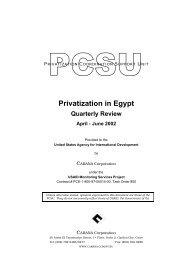
![Download entire catalog in pdf format [1.5MB] - The American ...](https://img.yumpu.com/51079239/1/190x260/download-entire-catalog-in-pdf-format-15mb-the-american-.jpg?quality=85)

